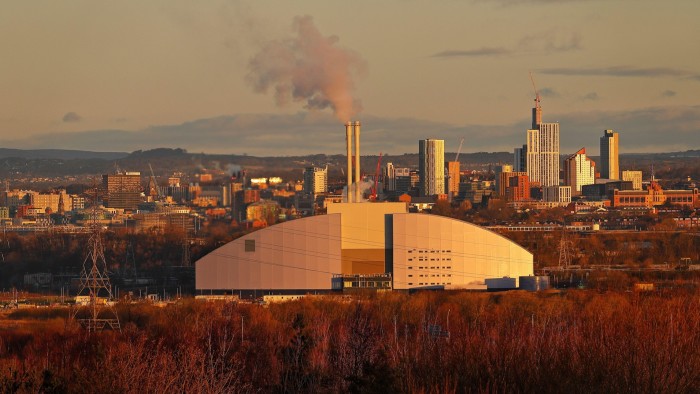In Parc Adfer, North Wales, incinerator owner Enfinium is testing a new technology to capture some of the 218,967 tonnes of carbon dioxide that it spews out of its chimneys every year.
The company — which generates power from waste — is aiming to clean up its output. But it also hopes eventually to be paid by other factories and power plants for reducing the amount of CO₂ they put into the atmosphere.
That could become a reality under a proposed shake-up of the UK’s CO₂ emissions trading scheme, which would see allowances for carbon removals trade alongside regular allowances for emissions.
The UK government believes the changes will help fund fledgling technologies that remove CO₂ from the atmosphere — for instance by sucking it out of the air or, companies hope, stripping out carbon released when burning wood chips or biogenic household waste — but which have struggled to attract funding. It launched a consultation in May last year and is due to publish the results sometime this year.
But critics warn the rewards are not great enough to encourage investment into expensive carbon removal technologies, and that the plans risk undermining the current emissions trading scheme, ultimately weakening efforts to lower CO₂ in the atmosphere. It is also hard to verify and monitor whether a tonne of carbon has really been “removed”, they warn.
“We think [the change] is premature,” said Sam Van den plas, policy director at Carbon Market Watch, a research group. “It would distract from the immediate priority to reduce emissions at source.”
The debate highlights the challenge for lawmakers around the world in developing market mechanisms to help mitigate climate change. Japan last year became the first country to include carbon removals in its own emissions trading scheme, while the EU is also considering doing so.
The UK’s emissions trading scheme, which the government now wants to re-link with the EU’s after decoupling following Brexit, has been a key tool in reducing its CO₂ emissions, which currently stand at 289mn tonnes annually. The country has a legally binding target of cutting them to net zero by 2050.
Under the current scheme, polluting sectors are subject to a cap on their CO₂ emissions, which reduces steadily over time. They have to pay for these emissions by buying allowances issued by the government, which they can trade in the secondary market. The government also issues some allowances for free. Each allowance represents the right to emit a tonne of CO₂.
The proposed shake-up would see the UK government issue allowances to companies deemed to have removed carbon from the atmosphere. They could then sell these to polluters to meet their obligations under the emissions trading scheme.
Companies have long been able to buy credits for carbon removals to show shareholders and customers they are offsetting emissions. But this would mark the first time in the UK that they could use them to meet their legal requirements.
UK ministers say allowing polluters to buy these allowances could help jump-start such so-called “engineered greenhouse gas removal” technologies. Such technologies, which are not currently running at scale in the UK, will need to be removing about 35.8mn tonnes of CO₂ equivalent per year by 2050, according to the UK government’s climate advisers, who support the introduction of greenhouse gas removal allowances.
Enfinium, the incinerator owner, hopes to be awarded removal allowances for emissions captured and stored from burning biogenic or organic waste eg food leftovers.
Drax, the UK’s largest biomass power plant owner, also supports the scheme. It told the Financial Times the plans could “help facilitate the deployment and scale up carbon removal technologies”.
A spokesman for the UK government’s Department for Energy Security and Net Zero said it was “looking to integrate green gas removals into the UK Emissions Trading Scheme to help meet the UK’s net zero goals while supporting economic growth”. The spokesman added it had not yet decided which removal technologies would be awarded allowances.
The government is planning initially to issue one fewer regular allowance for every “removals” allowance introduced, to maintain the planned cap on total allowances and avoid deterring factories from doing the hard work of reducing emissions at source.
Some experts say that approach could work. By doing this, “the UK government provides a clear demand signal to incentivise removals without reducing the abatement signal for polluters”, said Marcus Ferdinand, chief analytics officer at consultancy Veyt.
But, over the long term, the cap is meant to fall to zero, meaning there would not be enough regular allowances to be replaced by removals credits.
Moreover, the price of allowances may not be high enough to encourage expensive greenhouse gas removal technologies, some argue.
Veyt estimates bioenergy with carbon capture currently costs about £330-£400 per tonne of carbon captured, while direct air capture costs about £990-£1,200 per tonne. UK carbon allowances currently trade at just over £50 per tonne.
“Some of the technological carbon removal solutions go well into the hundreds of euros per tonne of CO₂,” says van den Plas. “They won’t be delivered by current carbon price signals.”
He warned such prices may merely incentivise removals projects such as growing forests, which are cheaper but potentially less permanent as they can be destroyed by fire.
Verifying and monitoring removals is a key issue for the scheme, say analysts. The government says it will only admit removals where the “storage provided is highly durable, and risks of leakage are minimal”.
But emissions from supply chains are harder to gauge and the permanence of removals can only be tested over time, say critics. Drax was last year told by the UK’s energy regulator to audit its biomass supply chain after it misreported some data. The government has asked the British Standards Institute to help develop criteria.
“Standards are really at the crux of this issue,” says Navraj Singh Ghaleigh, senior lecturer in climate law at the University of Edinburgh and a member of CO₂RE research group. “There are huge gaps — and I think developing those gaps in a way in which financial actors can rely on them is going to be a real challenge.”
He also warned of the risk that creating credits for removals could damage the way allowances are perceived, ultimately undermining the incentive to reduce existing emissions.
“I think it creates a perception among market actors that these two things are fungible,” he said. “That if you remove, you don’t have to mitigate. And that’s a very dangerous position.”
Climate Capital

Where climate change meets business, markets and politics. Explore the FT’s coverage here.
Are you curious about the FT’s environmental sustainability commitments? Find out more about our science-based targets here

